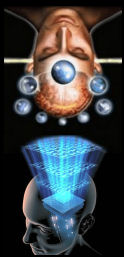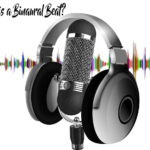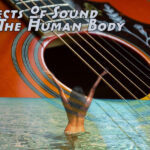 Binaural beats can easily be heard at the low frequencies (< 30 Hz) that are characteristic of the EEG spectrum (Oster, 1973). This perceptual phenomenon of binaural beating and the objective measurement of the frequency-following response (Hink, Kodera, Yamada, Kaga, & Suzuki, 1980) suggest conditions that facilitate entrainment of the brain waves and altered states of consciousness. There have been numerous anecdotal reports and a growing number of research efforts reporting changes in consciousness associated with binaural beats. “The subjective effect of listening to binaural beats may be relaxing or stimulating, depending on the frequency of the binaural-beat stimulation” (Owens & Atwater, 1995). Binaural beats in the delta (1 to 4 Hz) and theta (4 to 8 Hz) ranges have been associated with reports of relaxed, meditative, and creative states (Hiew, 1995), and are used as an aid to falling asleep. Binaural beats in the alpha frequencies (8 to 12 Hz) have increased alpha brain waves (Foster, 1990) and binaural beats in the beta frequencies (typically 16 to 24 Hz) have been associated with reports of increased concentration or alertness (Monroe, 1985) and improved memory (Kennerly, 1994).
Binaural beats can easily be heard at the low frequencies (< 30 Hz) that are characteristic of the EEG spectrum (Oster, 1973). This perceptual phenomenon of binaural beating and the objective measurement of the frequency-following response (Hink, Kodera, Yamada, Kaga, & Suzuki, 1980) suggest conditions that facilitate entrainment of the brain waves and altered states of consciousness. There have been numerous anecdotal reports and a growing number of research efforts reporting changes in consciousness associated with binaural beats. “The subjective effect of listening to binaural beats may be relaxing or stimulating, depending on the frequency of the binaural-beat stimulation” (Owens & Atwater, 1995). Binaural beats in the delta (1 to 4 Hz) and theta (4 to 8 Hz) ranges have been associated with reports of relaxed, meditative, and creative states (Hiew, 1995), and are used as an aid to falling asleep. Binaural beats in the alpha frequencies (8 to 12 Hz) have increased alpha brain waves (Foster, 1990) and binaural beats in the beta frequencies (typically 16 to 24 Hz) have been associated with reports of increased concentration or alertness (Monroe, 1985) and improved memory (Kennerly, 1994).
 Passively listening to binaural beats may not spontaneously propel you into an altered state of consciousness. One’s subjective experience in response to binaural-beat stimulation may also be influenced by a number of mediating factors. For example, the willingness and ability of the listener to relax and focus attention may contribute to binaural-beat effectiveness in inducing state changes. “Ultradian rhythms in the nervous system are characterized by periodic changes in arousal and states of consciousness (Rossi, 1986; Shannahoff-Khalsa, 1991; Webb & Dube, 1981).
Passively listening to binaural beats may not spontaneously propel you into an altered state of consciousness. One’s subjective experience in response to binaural-beat stimulation may also be influenced by a number of mediating factors. For example, the willingness and ability of the listener to relax and focus attention may contribute to binaural-beat effectiveness in inducing state changes. “Ultradian rhythms in the nervous system are characterized by periodic changes in arousal and states of consciousness (Rossi, 1986; Shannahoff-Khalsa, 1991; Webb & Dube, 1981).
These naturally occurring shifts may underlie the anecdotal reports of fluctuations in the effectiveness of binaural beats. External factors are also thought to play roles in mediating the effects of binaural beats” (Owens & Atwater, 1995). The perception of a binaural beat is, for example, said to be heightened by the addition of white noise to the carrier signal (Oster, 1973), so white noise is often used as background. “Music, relaxation exercises, guided imagery, and verbal suggestion have all been used to enhance the state-changing effects of the binaural beat” (Owens & Atwater, 1995). Other practices such as humming, toning, breathing exercises, autogenic training, and/or biofeedback can also be used to interrupt the homeostasis of resistant subjects (Tart, 1975).

| Bibliography |
| Atwater, F.H. (1997). The Hemi-Sync process. https://www.MonroeInstitute.org/research/ |
| Foster, D. S. (1990). EEG and subjective correlates of alpha frequency binaural beat stimulation combined with alpha biofeedback. Hemi-Sync Journal, VIII (2), pp. 1-2. |
| Hiew, C. C. (1995). Hemi-Sync into creativity. Hemi-Sync Journal, XIII (1), pp. 3-5. |
| Hink, R. F., Kodera, K., Yamada, O., Kaga, K., & Suzuki, J. (1980). Binaural interaction of a beating frequency following response. Audiology, 19, pp. 36-43. |
| Kennerly, R. C. (1994). An empirical investigation into the effect of beta frequency binaural beat audio signals on four measures of human memory. (Department of Psychology, West Georgia College, Carrolton, Georgia). |
| Monroe, R. A. (1985). Far Journeys. (New York: Doubleday). |
| Oster, G. (1973). Auditory beats in the brain. Scientific American, 229, pp. 94-102. |
| Rossi, E. L. (1986). Altered states of consciousness in everyday life: The ultradian rhythms. In B. |
| Shannahoff-Khalsa, D. (1991). Lateralized rhythms of the central and autonomic nervous systems. International Journal of Psychophysiology, 11, pp. 225-251. |
| Tart, C. T. (1975). States of Consciousness. pp. 72-73. (New York: E. P. Dutton & Company). |
| Webb, W. B., & Dube, M. G. (1981). Temporal characteristics of sleep. In J. Aschoff (Ed.), Handbook of Behavioral Neurobiology, pp. 510-517. (New York: Plenum Press). |

